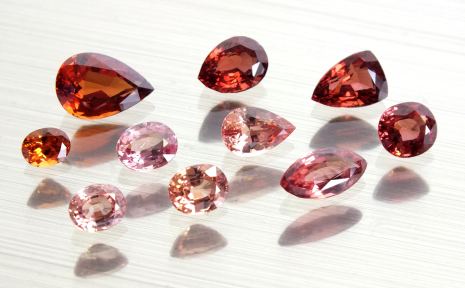 |
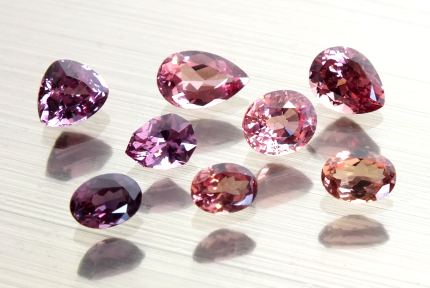 |
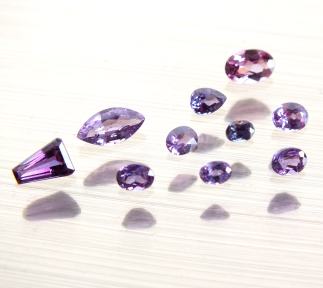 |
| マライア・ガーネット (Malaia
Garnet) 0.66 - 3.22ct |
アレクサンドライト型パイロープ ー スペッサータインガーネット (Alexandrite type Pyrope - Spessertine Garnet) 1.08 - 2.39ct |
青紫色のガーネット (Violetish blue
color garnet) 0.13-0.69ct |
| Tanzania, Srilanka and Madagascar | ||
パイロープー・スペッサータイン
(Pyrope-Spessartine)
 |
 |
 |
| マライア・ガーネット (Malaia
Garnet) 0.66 - 3.22ct |
アレクサンドライト型パイロープ ー スペッサータインガーネット (Alexandrite type Pyrope - Spessertine Garnet) 1.08 - 2.39ct |
青紫色のガーネット (Violetish blue
color garnet) 0.13-0.69ct |
| Tanzania, Srilanka and Madagascar | ||
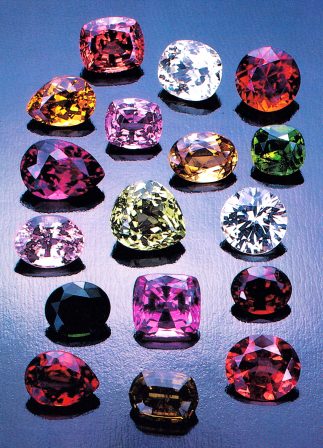 |
 |
A : malaia B : grossular C : pyrope-spessartine D : hessonite E : rhodolite F : grossular G :: demantoid H : color-change pyrope-spessartine I : pyrope J : tsavolite K : grossular L : tsavolite M : rhodolite N : chrome pyrope O : spessartine P : demantoid Q : spesartine |
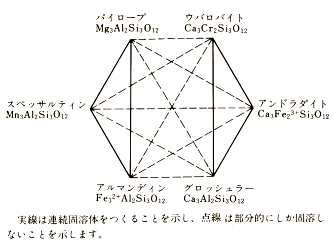 | |||
| Garnet samples from GIA collection : 1.08 - 2.91ct | 各種ガーネットの固溶体生成図解 | |||||
| 化学組成 Composition |
比重 Specdific Gravity |
屈折率 Refractive Index | |
| 苦礬柘榴石 (Pyrope) | Mg3Al2(SiO4)3 | 3.62-87 | 1.720-756 |
| 鉄礬柘榴石 (Almandine) | Fe3Al2(SiO4)3 | 3.93-4.17 | 1.76-82 |
| 満礬柘榴石 (Spessartine) | Mn3Al2(SiO4)3 | 4.12-30 | 1.78-82 |
| 灰礬柘榴石 (Grossular) | Ca3Al2(SiO4)3 | 3.34-73 | 1.72-75 |
| 灰鉄柘榴石 (Andradite) | Ca3Fe2(SiO4)3 | 3.81-87 | 1.855-895 |
| 灰格柘榴石(Uvarovite) | Ca3Cr2(SiO4)3 | 3.77 | 1.86-87 |
柘榴石は成分の違いにより多彩な種類の一大グループを成す鉱物です。
そしてどの柘榴石も純粋な成分からなるものは皆無といってもよく、図解のように複数の柘榴石成分を含む固容体として産出します。
そうした複雑な成分を持つ柘榴石の中で、主にパイロープとスペッサータインを主成分とする種類があります。
1960年代後半からタンザニアとケニア国境のウンバ川流域地帯とトゥンドゥルー、スリランカのエンビリピティヤとアティリウェワ、最近ではマダガスカルのイラカカ鉱床からも発見されました。
タンザニアのロードライト (パイロープ・アルマンダイン) 鉱床から紫色のロードライトに混じって時折発見されていた奇妙な橙色や赤みを帯びた橙色の柘榴石は、商品としては全く評価されませんでした。
このため鉱夫たちは、スワヒリ語で ”役立たたず” とか ”娼婦”、一般的に ”屑” を意味する侮蔑的な呼称である”マライア”と呼んで捨てられていたものです。
後にアメリカやドイツの宝石商が試しにカットしてみたところ中に大変美しいものがあり、マライア・ガーネットとして一躍人気商品となりました。
ヨーロッパでは元のスワヒリ語の呼称はあんまりひどすぎると、産地 (ウンバ川流域) に因んでウンバライトと呼ばれることもありますが、一般には ”マライア” の呼び名が通用しています。
さらに、クロムやヴァナジウムを含んで顕著な色変わりを示す変種も発見され、アレクサンドライト型ガーネットとして注目を集めました。
これらはいずれもパイロープースペッサータインを主成分とするガーネットではありますが、個々のガーネットによりその成分は様々で、詳細な分析をすると、グロシュラーやアルマンダインをかなり含み、さらにショーロマイト (Ca3Ti3Fe3+2O12), ヤマトアイト (Mn3V2Si3O12:スペッサータインのアルミニウムがヴァナジウムに置換された変種), アンドラダイト,ウヴァロヴァイトと、全ての柘榴石成分を含むな標本も少なくありません。
アルマンダイン成分を比較的に多く含むためパイラルスパイト (パイロープーアルマンダインースペッサータイン) と呼ばれることもあります。
類似したガーネットの見分け方 ( How to identify similar looking garnets )
縦軸に屈折率、横軸に比重、各種の柘榴石の分布のグラフ上の正体不明の柘榴石
(Intriguing garnets plotted on property diagram)
Grossular (Hessonite)Spessartine Malaia(Pyrope-Spessartine) Malaia(Pyrope-Spessartine) Spessartine Grossular(Hessonite)
複雑な色合いの柘榴石の正体を突き止めようとしても高級な分析機器を持たない素人のコレクターには複雑な成分の柘榴石を識別するのは至難の技です。
上の写真の3個の色合いがそっくりの赤褐色の柘榴石は、専門家がスペクトロスコープに拠る吸収線特性によりそれぞれヘソナイト、スペッサータイン、マライアと判別しましたが、素人のハンディ型ではこんなにはっきり吸収線は見えないのが現実です。
したがって比重を何回も慎重に計った上で平均値を取り、小数点以下二桁の精度しか読めないレイナーの屈折率計での値と、簡単に3桁の表示が得られるものの、誤差が大きく信頼性には問題があるレーザーによる屈折計の値とを参考に、最後は微妙な色合いを勘案して個々の標本が何であるかの判断となります。
こうして精密に測って得られた特性の数字だけを眺めたところで、個々の柘榴石の素性は容易には分かりません。
が上のダイアグラムのように横軸に比重、縦軸に屈折率を取り、それぞれの柘榴石の分布図を描いて、特性を測った正体不明の石を置いてみると、ようやく個々の石の位置付けが一目瞭然で判明しました。
まさに目からウロコと言える方法でした。
The garnet group of minerals encompasses complex variations in chemical composition and practically all garnets found in the nature are more or less, mixture (solid solution) of various garnet components.
Among them is an intriguiging group called pyrope-spessartine, discovered since end of 1960's along the border of Kenya and Tanzania, Umba river area, Tunduru, southern Tanzania and at Embilipitiya, Srilanka.
New localities are reported recently at Ilakaka, Madagascar and at Athiliwewa, Srilanka.
While first discovered at alluvial deposits of rhodolite (pyrope-almandine) garnet in Tazania, because the strange orange or reddish-orange specimens were not appreciated from foreign dealers at all, miners threw them away, calling "Malaia" a Swahili word that means first "outcast" and second "prostitutes" but connoting avobe all "trash".
But lator on, some Americans and Europeans tried to polish this nuisance garnet to find them beautiful and in no time at all, the new garnet went from outcast to "in" thing as "Malaia garnet". In Europe, it is called "Umbalite" after the first locality, avoiding the contempting meaning. But now "Malaia" name dominates the gem trade.
In addition, a new type, showing alexandrite-like color change, with chrome and vanadium impurity was also discovered in East Africa and in Srilanka.
Both malaia and alexandrite types garnets are mixture of mainly pyrope and spessartine but are mongrel garnet, part grossular, almandine, schorlomite (Ca3Ti3Fe3+2O12), yamatoite (Mn3V2Si3O12), andradite and uvarovite.
Sometimes they are called in gem trade "Pyralspite (pyrope-almandine-spessartite)" because of relatively higher almandine component.
2nd line photo shows typical color example of various garnets. In the nature there are complex mixtures of them and sometimes we encounter indeed intriguing specimens.
Top photo shows example of complex mixture of such garnets, left in my hand as unidentifiable garnets for long time.
マライア・ガーネット (Malaia Garnet)
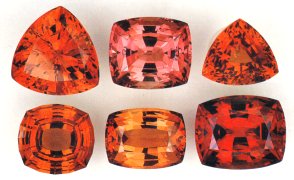 |
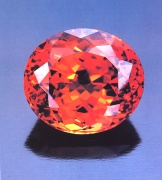 |
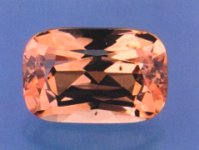 |
| 様々な色合いのマライア・ガーネット Color variations of Malaia Garnet East Africa |
14.19ct Tanzania |
"Imperial Malaia Garnet"
1.16ct R.I.: 1.760 S.G.: 3.89-90 Madagascar |
| |
 |
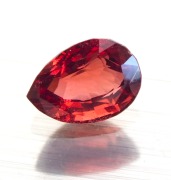 |
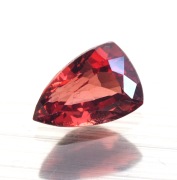 |
 |
 |
| 1.43ct
10.5x5.5mm RI : 1.777 SG : 3.915 |
1.94ct 8.4x6.5mm RI : 1.804 SG : 3.890 |
1.91ct 9.1x6.1mm RI : 1.764 SG : 3.762 |
3.21ct 11.6x7.7mm RI : 1.777 SG : 3.915 |
1.58ct 7.0x6.3mm R.I. 1.798 |
| Tanzania? | Tanzania ? | Tanzania ? | Srilanka | Bekily, Madagascar |
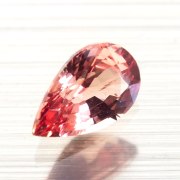 |
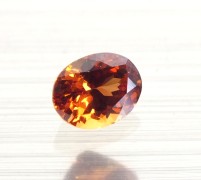 |
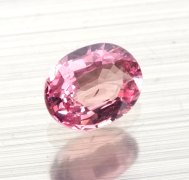 |
 |
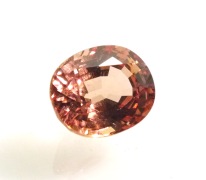 |
| 1.39ct 8.6x5.1mm RI : 1.804, SG : 3.806 |
0.66ct 5.6x4.1mm RI : 1.806, SG : 3.644 |
1.085ct 6.5x5.1mm RI: 1.797, SG : 3.698 |
1.13ct 7.1x5.4mm RI : 1.794, SG : 3.629 |
1.13ct 6.7x5.4mmmm RI : 1.783, SG : 3.897 |
| Tanzania | Umba Valley, Tanzania | Bekily, Madagascar | ||
マライアとは前述のように1970年代初頭の頃からケニアとタンザニア国境のウンバ川流域の主にロードライト(パイロープーアルマンダイン)鉱床から時折発見された柘榴石です。
当初、ロードライトを買い付けに来ていた外国のバイヤーからは全く相手にされず、売り物にならなかったのでスワヒリ語で"屑”等を意味する”マライア”と呼ばれていた名前が世界的に定着してしまいました。
マライアとはしたがって商業名なのですが、鉱物としての素性は一般には主にパイロープースペッサータインということになっています。
しかしながら比重、屈折率と色合いとを勘案すると、パイロープースペッサータインを主成分としますが、個々の石またはロット毎に変動するあらゆるガーネット成分を含む雑種と考えた方が正しいかと思います。
主な産地はいずれもタンザニア北部、ケニア国境のウンバ川流域と南部のモザンビーク国境に近いソンジャ川流域のトゥンドゥルーに1993年頃に発見された漂砂鉱床です。
さらに1994年にはマダガスカル中央部から淡い橙を帯びたピンクのものが報告され、インペリアル・マライア・ガーネットとして販売され始めたようです。
こぶし大の亀裂と内包物多い結晶中の僅かに透明な部分がカットされるので平均では1カラット以下、最大でも4ct未満のルースしか得られません。
スリランカ産 3.21ct ペア・カットの石は30年昔にツーソンにてスリランカの業者から入手したものです。
写真では橙に見えますが、肉眼ではやや赤みを帯びた爽やかな透明感に満ちた色合いです。
当時から正体が分からず、業者もスペシャルと言っていましたが、特性や色合いからマライアと判断しています。 1.43ctのマーキーズ・カット、 1.94ctのペアカットと1.91ctの楯型カットの石は最近スリランカ産のジルコンとして入手したものですが、比重、屈折率からおそらくタンザニア産のマライア型と判断しました。
下段の写真の内3点は淡い色のロードライト (パイロープ・アルマンダイン) を思わせる色合いですが、比べると橙色を帯びていてすこし違います。これもアルマンダイン成分を含むマライアと呼ぶ種類と判断しています。
Malaia is a name given to orange and reddish-orange garnet discovered in early 1970's at rhodolite alluvial mines along Umba river. Since foreign dealers did not pay attention to this new specimen with strange color, miners threw them away this worthless garnet, calling as "Malaia", meaning "outcast" in their language, which is now widely employed in gem trade.
Malaia is therefore, a commercial name for orange to reddish-orange variation pf pyrope-spessartine garnet. However, density, reflactive index and hue suggests that it is a complex mixture of pyrope-spessartine with all garnet species with great variations by each stone and lot.
Major localities are both alluvial deposits ; Umba river, northern Tanzania and Kenya border, then in 1993, discovered at Tunduru, southern Tanzania, and in 1994, pale orangish-pink stone was reported from central Madagascar. This new type is being promoted with "Imperial Malaia garnet", which is found as fist size crystal with numerous fractures and inclusions, resulting extremely low yield of eye-clean facetted stones, averaging less than 1ct and maximum stone of less than 4ct.
3.22ct pear cut stone from Srilanka of 2nd line photo is a old stock obtained in 1986 in Tucson. The color in daylight with naked eye is slightly purplish and with high transparency. The Srilankan dealer could not identify exactly what this stone was and insisted on this as "special". Upon it's property and color, I classify it as malaia, although there are no official report from Srilankan origin. Next two purple stones from Tanzania look rhodolite, but with orangish hue, they are different compared with rhodolite. It should be classified as malaia with relatively higher almandine component.
アレクサンドライト型ガーネット (Alexandrite type garnet)
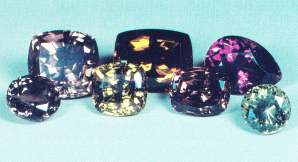 |
 |
||
| 太陽光(Daylight) | 白熱光(Incandescent light) |
太陽光では緑に、白熱光では赤に色変化を起こすクリソベリル(金緑色)の変種がウラル山脈で発見されたのは1830年のことでした。
それはロシアの皇太子アレクサンドルの成人式の日でもあり、さらにロシア帝国陸軍の緑と赤の軍服の色でもあったので、このウラル特産の宝石はアレクサンドライトと命名され稀少な宝石として宝石愛好家の垂涎の的となりました。
同様の色変わりを示す宝石はその後サファイア (1950年代)、スピネル (1980年)、カイアナイト (1967年)、蛍石 (1978年)等、続々と報告されるようになって来ています。
同様のガーネットの存在は1960年末頃からスリランカとタンザニアーケニア国境の、いずれも漂砂鉱床から報告されていました。さらにかつてガーネットにはなかった青い色の色変わりを見せるものが1996年にスリランカの新しい産地から報告されました。
スリランカ産の青いガーネット (Blue garnet from Srilanka)
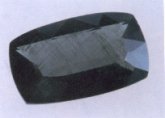 |
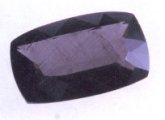 |
| 太陽光 (Daylight) | 白熱光 (Incandescent light) |
自然光下で青みを帯びた緑色のアレクサンドライト型ガーネットは過去にいくつか報告されていましたが、1996年に新たにアレクサンドライト型ガーネットの産地として登場したスリランカのアティリウェワから自然光で暗い青に、白熱光では青紫に見えるものが報告されました。
分析の結果マグネシウム、アルミニウム、マンガンを主成分とするパイロープ・スペッサータインと判明しました。
この色合いは主にヴァナジウムとマンガンによるものと考えられています。
暗い灰色を帯びたインクルージョンをかなり含んでいますが、ガーネットとしては初めて青い色のものが発見されたことになります。
しかし、その後同様の色合いのガーネット発見は全く報告されませんでした。
Although bluish-green alexandrite type garnets had been reported, blue garnet was first reported in 1996. It was from Athiliwewa, Srilanka, 2nd alexandrite type garnet locality. 0.99ct specimen of the photo looks dark blue in daylight and bluish-purple in incandescent light. At the same time 0.48 and 0.59ct similar stones were collected. Detailed analysis revealed that they are pyrope-spessartine with magnesium, aluminum, mangane as major components. There are no additional reports about blue garnet discovery.
新たに発見された青いガーネット(New blue garnet) pyrope-spessartine 0.22ct 4.3x3.1mm
R.I.: 1.75 S.G. : 3.61pyrope-spessartine 0.29ct 4.4x3.2mm
R.I. : 1.76 S.G. : 3.65太陽光 (Daylight) 白熱光 (Incandesdent light) 太陽光 (Daylight) 白熱光 (Daylight)
0.13ct (3.5x2.6mm) - 0.63ct (8.0x4.2mm)
Ateliwea ? , Srilanka2005年10月に小さいながら色変わりをするガーネットが日本の市場に現れました。
自然光で青、白熱光では赤紫となる石でした。
いずれもスリランカ産の古いストックをインドのジャイプールにて研磨したとのことです。
前述の1996年に報告されたものと比べると小さいながら透明度が高く鮮明な色合いです。
詳細な産地は不明ですが、色合いは先のアティリウェワ産とよく似ていますから、同じ産地の可能性があります。
さらにイダー・オーバーシュタインで研磨されたかと思われるほどの見事なカットで改めて世界のダイアモンドの90%を研磨しているジャイプールの水準の高さを見直しました。
In October, 2005 blue garnets appeared in Japanese market. There are 4 pcs color change garnets of which 3 pcs show blue to violet color change. Especially one small 0.22ct clean facetted stone is violet-blue color in daylight and turns to reddish violet in incandescent light. Another two small stones, both 0.29ct, are violetish blue in daylight and turn to reddish violet in incandescent light. A 0.59ct facetted clean stone is pale bluish violet and turns to reddish violet in incandesdent light.
These four stones are said to have come from old stock of Srilanka and were facetted in Jaipur, India. The quality of their facetting is such high level as to remid me of Idar-Oberstein work.
* 参考 : 4%以上の高濃度でクロムを不純物として含むパイロープは全て自然光では青緑に、白熱光ではワインのような赤紫色のアレクサンドライト効果を示すことが1972年以来知られています。
ただし亀裂が多く宝石質ではなく、さらに0.5ct以下と小さな結晶しか採れないため、宝石として研磨されません。
* Reference : Pyrope with high chrome impurity over 4% is known to show alexandrite effect since 1972.
They look bluish-green in daylight and reddish violet wine color in incandescent light. However, they are rarely faceted because of small size (less than 0.5ct) with fractures.
アレクサンドライトの色変わりの仕組み ( Color change mechanism of alexandrite)
色変わりを示す宝石の大半は不純物としてクロムやヴァナジウムを含んでいます。
個々の宝石により色合いは異なりますが、美しい色変わりを見せるアレクサンドライトに因んで、一般的にアレクサンドライト型と呼ばれます。
アレクサンドライトの場合、不純物として含まれるクロムとヴァナジウムは黄色(波長が550〜600nm)の帯域が吸収され高い波長の緑〜青、紫と低い波長の橙〜赤はほぼ同じ強さで出てきます。
しかし赤の周波数帯域の少ない太陽光や蛍光灯下では緑が強く目立ち、逆に青の周波数帯域の少ない白熱光下では赤が目立って見えるというのが、異なる光で色変わりして見える仕組みです。
Most of color change gem stones contain chrome or/and vanadium as impurity. Hue varies depending on each stone, and they are called alexandrite type, in general.
In case of alexandrite, chrome and vanadium impurity cause the absorption of yellow (550 〜600nm) band, then higher frequency band (green, blue to violet) and lower frequency band (orange to red) colors are transmitted as same level. When viewed under less reddish light (daylight and fluorescent light) green color is intensified, while under incandescent light、which has less bluish frequency band, red is intensified.
This is why alexandrite shows different colors by lighting condition.
Color change Garnet
太陽光(Daylight) 白熱光(Incandescent light) 自然光 (Daylight) 白熱光 (Incandecent light) 1.35 - 2.14ct Tanzania 0.69ct 6.5x4.3x2.2mm Bekily ?, Madagascar
色変わりを見せるガーネットは1970年代初め頃から報告されてはいました。
しかしながら、その多くが美しいというよりは風変わりな色合いを見せるのみ、その上産出量が極めて少なく一部の宝石学者とコレクターの注目を集めるだけでありました。
状況が一変したのは、1987年にタンザニアのウンバ川流域でロシアの最上のアレクサンドライトに匹敵する鮮やかなエメラルド・グリーンからルビーの赤に色変わりするものが発見されたためです。
写真は全部で4個の標本の中の3個です。
発色は0.1wt.%しか含まれないクロムではなく、主に1wt.%含まれるヴァナジウムに因るものです。
その後各地から同様の色変わりをする標本が報告されていますが、これほど見事な例はなくまさに宝石の世界にとっては空前絶後の標本でした。
これをきっかけに色変わりをするガーネットの人気が沸騰したのは言うまでもありません。
近年はマダガスカル各地からもアレクサンドライト型のガーネットが登場しました。
While color change garnet has been reported since early 1970's it was noted by limitted gemologists and gem collectors because of too little production and colors, most of which were acknowledged as strange rather than beautiful color.
The situation changed totally, when in 1987 at Umba Valley, Tanzania, the best Russian alexandrite-like color change type was discovered to raise the great exitement to color change garnets. This superb color change is caused by 1 wt.% vanadium impurity rather than 0.1 wt.% chrome.
Similar color change garnets discovery have been followed, but few stone equals to that 1987 ones.
アレクサンドライト型ガーネットの色変化の現れ方
(Color change/shift phenomena in alexandrite-type ganet)
蛍光照明 (Fluorescent light) 白熱光照明 (Incandescent light) 反射光 (Reflected light) 透過光(Transmitted light) 反射光 (Reflected light) 透過光 (Transmitted light)
色変わりの原因は主にクロムとヴァナジウムを不純物として含むためですが、しかしガーネットの場合、二つの点でアレクサンドライトとは異なる発色の仕組みがあります ;
一つは上の写真のように一つの石が蛍光と白熱光、反射光と透過光での色合いが変わって見えることです。
アレクサンドライトではこのような現象は起こりません。
次は、スペッサータインの主成分であるマンガンイオンと、アルマンダインの主成分である鉄イオンの存在が色変わりに重要な影響を及ぼしていることです。
これらの遷移元素による光の吸収はある部分でクロムやヴァナジウムによる吸収帯域と重なったり、あるいは全く別の帯域での吸収の影響により、より複雑な色合いの原因となります。
Although chrome and vanadium impurity causes the color change, garnet has two additional color change mechanisms ;
First is, as shown in above photo, color changes not only with a change in light sources, but also influenced by reflected light and transmitted light.
Second is the existence of additional coloring agents, mangan ion as major component of spessartine and iron ion of almandine.
1.95ct 10.3x6.5mm
RI : 1.806, SG : 3.8902.36ct 9.2x7.2mm
RI : 1.803, SG: 3.8062.22ct 8.3x7.0mm
RI : 1.802, SG : 3.6981.08ct 7.1x5.3mm
1.798, SG : 3.574Tanzania Tanzania Tanzania Tanzania
これらのガーネットは純度の高いパイロープのように見えます。
が屈折率が高く、スペッサータインとの混合種です。
明瞭な色変わりこそ見せませんが、白熱光下ではピンク・サファイアのように美しい煌めきが楽しめます。
オレンジ色を帯びた色合いは、マライア型にも極めて近い種類と思われます。
These pinkish orange garnets look like pure pyrope. However, high Refractive Index tells that they are mixure with
spessartine and almandine. Under incandescent lighting, they sparkle like pink sapphire. Slightly orangish hue remind me
that they are close to so-called Malaia garnet.
1.09ct 7.6x5.6mm
RI : 1.811, SG :3.5672.39ct 8.5x7.3mm
RI : 1.777, SG : 3.4701.44ct 7.8x5.5mm
RI : 1.805, SG : 3.7201.40ct 8.0x5.7mm
RI : 1.802, SG : 3.720Srilanka Srilanka Srilanka Tanzania
これらのガーネットは自然光ではブラジル、ミナスジェライスのエマチータ鉱山産のアレクサンドライトのような濃い赤紫色をしています。
チェルシー・フィルターを通してみるとクロムやヴァナジウムを含むため濃い赤に見えます。
白熱光によって顕著な色変わりこそ見せませんが、しかし濃いピンクに輝き印象が一変します。
These garnets have deep reddish violet color, like alexandrite from Hematita mine, Minas Gerais, Brazil and appear deep red through chelsea filtor due to chrome and vanadium impurity. They do not show spectacular color change as expected, but under incandescent light sparkle in deep pinkish color.